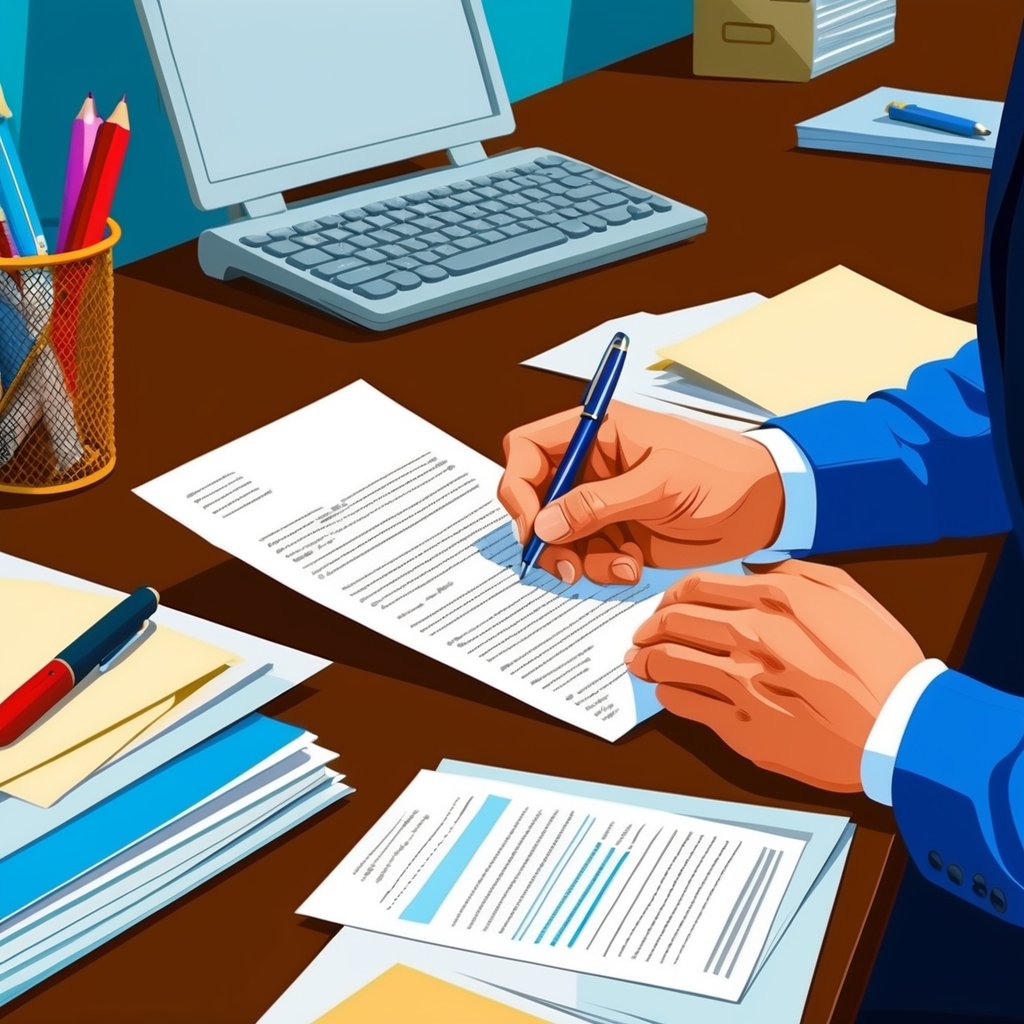Writing a resignation letter can feel stressful, but it does not have to be complicated. A strong resignation letter should clearly state your intention to leave, include your last working day, and keep a professional and polite tone. This simple step helps maintain good relationships and makes your future job transitions smoother.

The right resignation letter is more than just putting words on paper—it’s about leaving on good terms and protecting your reputation. Following a clear process and including the right details helps make your exit as stress-free as possible. If you need help or want to see easy templates, there are helpful guides on how to write a resignation letter.
Key Takeaways
- A clear and polite resignation letter is important for leaving any job.
- Key parts of a resignation letter include your last day and a professional tone.
- Using templates and best practices helps make the process easier.
Understanding the Purpose of a Resignation Letter
A resignation letter is a written notice that allows an employee to share their decision to leave a job. Submitting a formal resignation can help protect work relationships and provide clear notice to an employer.
What Is a Resignation Letter?
A resignation letter is a short, formal document that declares an employee’s intent to leave their job. It usually includes the resignation date and sometimes a short reason for leaving.
Employers use this document to begin planning for the transition, such as hiring someone new or moving job duties to another team member.
It is standard practice across many industries. In most workplaces, employees are expected to write a resignation letter when leaving instead of simply telling a manager in person or over the phone. For more guidance, see this example of a resignation letter.
Why Formal Resignation Matters
A formal resignation letter is important because it documents the employee’s choice to leave. This helps avoid misunderstandings and can protect legal rights during the resignation process.
It also gives both the employee and employer a clear record of when the resignation will take effect. The letter can show that the employee left by choice and followed company procedures.
Most companies prefer a written letter, not just an email or spoken notice. Having this on file creates proof that both sides knew the details of the resignation. For more tips, check out the Handshake guide to writing a resignation letter.
Benefits of Resigning on Good Terms
Leaving a job on good terms keeps professional relationships positive. When resigning politely and with proper notice, employees are more likely to receive good references and support for future job searches.
A well-written resignation letter can help keep conversations civil and professional, even if there are problems leading up to the resignation. This is especially useful if the employee ever needs help from managers or coworkers later.
It is also common for employers to offer feedback or even invite the employee back in the future if the resignation is handled respectfully. Writing a clear and polite resignation letter is a key part of leaving a job the right way, as detailed by the Mānoa Career Center.
Key Elements of an Effective Resignation Letter
A clear and professional resignation letter contains a few important items. Including the right details helps both the employee and employer transition smoothly and keeps the process respectful.
Essential Components to Include
A letter of resignation should be direct and concise. The employee’s intention to leave must be stated right at the start. The position title and department should be listed for clarity, so there are no doubts about who is resigning.
Contact information, such as a phone number or personal email, is helpful if the employer needs to discuss arrangements. Including an expression of gratitude is recommended as it shows respect, even if the workplace was not ideal. For example, thanking the employer for opportunities or skills learned.
A professional closing is important. Signing the letter or adding a typed name keeps the tone formal. Any offers to help during the transition can be placed at the end, but this is optional. For more tips, see this step-by-step guide.
Checklist of Essentials:
- Name and position
- Statement of resignation
- Brief thanks
- Contact details
- Signature or typed name
Communicating Your Last Day of Work
Clearly stating the last day of work is key in a resignation letter. This helps avoid misunderstandings and supports a smooth handover.
Write the exact date the resignation will take effect. Don’t just mention “two weeks from now.” For example, state: “My last day of work will be May 16, 2025.” This makes scheduling and planning easier for both sides.
An exact last day lets managers start the process of hiring or transitioning others. It also helps staff prepare for a workload change or project transfers. Employers often expect this information, and it is a standard part of a formal resignation letter.
If needed, clarify if work will be finished before the last day or whether any projects need to be wrapped up. This shows the employee is being thoughtful and responsible.
Providing a Notice Period
Most companies expect a notice period when someone leaves their job. This is the time between when the resignation letter is given and the last day of work.
The notice period is usually two weeks, but it may be different depending on company policy or job contracts. Some jobs require more notice, especially higher positions or when projects are ongoing.
Including the notice period helps the employer prepare for the change. It gives them a chance to find a replacement or make a plan for coverage. This is a respectful step that keeps things professional.
If possible, mention the length of the notice period in the letter. For example, write “This letter provides two weeks’ notice” or state the specific dates. More guidance on this can be found in these resignation letter templates.
Step-by-Step Guide to Writing a Resignation Letter
A resignation letter should be clear, polite, and helpful to the employer. Choosing respectful words, explaining the decision, and offering support during the change are essential parts of this process.
Choosing a Professional Tone
Keeping a professional tone is important when writing a resignation letter. A polite greeting, like “Dear [Manager’s Name],” sets a respectful mood. The letter should avoid harsh words, gossip, or negative comments about coworkers or the company.
Using simple, clear sentences makes the message easy to read. The body of the letter should state the person’s plan to resign without sounding dramatic or upset. A short thank you shows appreciation for the experience gained while working at the company.
A formal closing, such as “Sincerely” or “Best regards,” keeps the letter courteous. This style helps leave a positive impression and shows maturity. For more tips and examples on professional writing, visit this guide to formatting a resignation letter.
Explaining Your Reasons for Leaving
Briefly stating the reason for leaving helps clear up any confusion. It is best to keep the explanation honest but simple. Reasons can include a new job, going back to school, moving, or personal growth.
Employees do not have to share all the details. It is enough to write, “I have accepted another position” or “I am relocating to a new city.” Avoid blaming anyone or discussing problems in detail.
The goal is to keep the focus on the decision itself, not on past issues. This approach keeps things positive and makes the process easier for both sides. For more detailed examples, visit this step-by-step guide on writing a resignation letter.
Offering Transition Assistance
Including an offer to help during the transition shows commitment and professionalism. The employee can write that they are willing to help train a new person, finish current tasks, or create a list of duties for the next person in the role.
A short list can be used:
- Training the replacement
- Writing handover notes
- Completing important projects
This kind of support helps make the company’s job easier during the change. It also helps maintain good relationships. Employers often appreciate clear offers for help because it keeps things running smoothly. For more tips, review this article with resignation letter examples.
Types of Resignation Letters
Different resignation letters suit specific needs and situations. Employees may choose to give notice, resign right away, or use a more detailed and formal approach depending on their circumstances.
Standard Two Weeks’ Notice
A standard two weeks’ notice letter is common in many workplaces. It lets an employee inform their employer that they plan to leave their position, with their last day two weeks from the notice date. This helps the company plan for replacement and transition of duties.
The main parts to include are the date, the statement of resignation, the last working day, and a thank you. Employees may also mention their willingness to help with the transition.
Using polite and professional language is important. For tips and templates, see these easy-to-use resignation letter examples.
Immediate Resignation Letter
An immediate resignation letter is used when someone must leave their job right away, without providing two weeks’ notice. This type of letter is necessary if there is a personal emergency, health problem, or another urgent issue.
The tone should remain polite and respectful even though the employee cannot give much notice. The letter should clearly state the resignation is effective immediately and, if possible, offer a short explanation.
Being brief and direct is best. The employee should thank the company for the opportunity and include their contact information for future communication. For quick tips, check out resignation letter etiquette guidelines.
Formal Letter of Resignation
A formal letter of resignation uses professional, business-like language and structure. This type is more detailed and follows traditional business letter formatting, which includes the sender’s and employer’s information, date, and a formal opening and closing.
Such letters are often used in larger companies or for higher-level positions. They should mention the position being resigned, the last working date, and a polite thank you.
The tone should stay courteous and positive. Employees may also express gratitude for specific experiences and offer help during the transition. Free templates for formal resignation letters make it simpler to get started.
Resignation Letter Examples and Templates
Resignation letters come in different styles depending on the situation. Some people need a simple letter, while others may want something more detailed or formal. Using examples and templates makes it easier to write a clear and polite notice of resignation.
Sample Letters for Different Scenarios
There are several types of resignation letter examples that match different situations. For example, a short and simple letter may only include the employee’s job title, final day, and thanks. Others might request a specific end date or give feedback to the employer.
A formal letter might begin with:
“Please accept this letter as formal notice of resignation from my position as [Job Title] at [Company Name]. My last day will be [Final Date].”
For special cases, such as resigning for health reasons or after a long tenure, the letter could include a short explanation or an offer to help during the transition. Many sample resignation letters are available online for different circumstances, which can help with wording and format.
Customizing a Template
It is helpful to start with a template, but each person should make changes to fit their own situation. People should fill in their personal details, like names, dates, and the specific reason for leaving if they choose to share it.
For a more personal touch, they can add a brief thank you or mention specific skills they learned on the job. It is important to keep the tone polite and the message clear. Sites such as Canva offer free resignation letter templates that are easy to edit and print, helping people create a professional letter quickly.
A table comparing typical elements:
| Element | Needed? | Example |
|---|---|---|
| Greeting | Yes | Dear [Manager’s Name], |
| Date of Resignation | Yes | Last day: June 5 |
| Reason for Leaving | Optional | For new opportunity |
| Thank You Statement | Recommended | Thank you for your support |
| Signature | Yes | Sincerely, [Your Name] |
Navigating the Resignation Process
A clear resignation process helps both the employee and the company. Notifying the employer, handling the transition period, and preparing for the exit interview are important steps that make leaving a job smoother.
Notifying Your Employer
An employee should tell their manager about their decision to resign as soon as possible. The standard notice period is usually two weeks, but some jobs may require more time. Giving enough resignation notice gives the company time to plan and start searching for a replacement.
A formal resignation letter, either as a physical copy or through email, is important. It should include the last working day and a short statement about leaving. Direct communication, such as a meeting or video call, is often preferred before sending the letter. More detailed steps and sample letters can be found at Indeed’s guide to resignation letters.
If possible, avoid resigning during very busy company periods. Being professional and polite during this stage is key to protecting work relationships.
Discussing the Transition Period
After giving notice, the next step is to talk with the manager about the transition period. This time is used to finish projects and transfer job duties. A clear transition plan shows responsibility and respect for the team.
Important tasks include:
- Creating lists of ongoing projects
- Documenting regular duties and key contacts
- Training team members or the new hire if there is time
The length of the transition period depends on the job and how quickly a replacement can start. Offering to help with training or answer questions makes the change easier for everyone. For further transition tips, see this detailed resignation process guide.
Open communication is encouraged to prevent confusion and ensure nothing is overlooked.
Preparing for the Exit Interview
The exit interview is usually done in the last days of employment. Human Resources often leads this meeting. The main goal is to learn why the employee is leaving and to get feedback about working at the company.
During the exit interview, employees should share honest but respectful opinions about their experience. Common conversation topics include:
- What went well in the job
- Challenges faced in the role
- Suggestions for improving the workplace
Being clear, calm, and factual in answers is best. Employees should avoid blaming others or discussing personal problems in detail. Preparing a few key points before the meeting helps keep the discussion focused and professional. For more about exit interviews and what to expect, visit Handshake’s resignation letter advice.
Best Practices for Resigning Professionally
Resigning professionally is important for keeping relationships strong in the workplace. Being respectful and following a proper process helps protect one’s future opportunities.
Maintaining a Positive Impression
Leaving a job on good terms starts with open and honest communication. An employee should give notice in writing and speak with their supervisor directly when possible. A clear resignation letter should state the final working day and express gratitude for the experience.
Staying professional until the last day is key. It is helpful to complete outstanding work, help with the transition, and avoid negative comments about the company or coworkers. These steps show respect, maturity, and care for the team.
A positive impression can leave the door open for networking and future opportunities. It also builds a good reputation that follows a person throughout their career.
Ensuring Future References
How a person leaves their job can affect their ability to get references in the future. Supervisors and colleagues are more likely to offer strong recommendations if the resignation is handled well. Giving proper notice, usually at least two weeks, is a standard courtesy in most workplaces.
Offering to help during the transition shows dependability. Sharing contact details can help former employers reach out for reference checks or offer networking support later. According to career experts, showing appreciation and maintaining a respectful attitude encourages positive feedback.
Taking these steps builds trust and keeps important professional contacts for the future.
Abiding by Company Policies
Each company has its own requirements when it comes to resigning. Employees should review their contract and the employee handbook to know the rules about giving notice, turning in keys or equipment, and handling remaining benefits.
Ignoring resignation policies can cause problems, such as losing final pay or damaging reputation. It is important to follow all formal steps before leaving and ask HR about any questions regarding resigning procedures. As Harvard Business Review suggests, at least two weeks’ notice is often expected for a smooth exit (see Harvard Business Review).
Following company policies shows professionalism and helps avoid issues during and after the transition.
Planning Your Next Steps After Leaving a Job
After leaving a job, many people want to find new ways to learn and earn, and handle their exit smoothly. It is helpful to prepare for this stage with a clear plan in mind.
Exploring Growth Opportunities
Looking for growth opportunities is an important step after leaving a job. Many people start by updating their resume and LinkedIn profile to show their most recent skills or projects. This helps them be ready for new job openings or freelance work.
Some workers take online courses or get certifications that fit their career plans. Others look into jobs in a new field, which can offer a fresh start and new challenges. Volunteering or working on side projects can also add to a person’s experience and help them build useful contacts.
Making a target list of companies he or she is interested in can save time during the job search. Taking small steps, like attending industry events, helps people stay connected and keep learning about the job market.
To see examples and templates for what to do next, reviewing these tips and templates for leaving a job and planning the next step can be helpful.
Managing the Transition Process
Managing the transition process is key for a smooth exit from one job and a clear start at another. People usually begin by giving proper notice and writing a professional resignation letter. It’s important to keep a copy for future reference.
Before leaving, they should wrap up any ongoing projects and give clear instructions for unfinished tasks. This helps the team or new hire take over easily. Returning company property, such as laptops or keys, is also part of the process.
Writing a list or table of actions can make the transition go more smoothly:
| Task | Notes |
|---|---|
| Give formal notice | Follow company policy |
| Resign in writing | Be polite and clear |
| Return company property | Collect receipts if needed |
| Finish active projects | Leave detailed instructions |
| Update personal records | Save important contacts |
Staying professional during the exit keeps a person’s reputation positive for future job opportunities. For more detailed advice, check these resignation process tips and examples.
Frequently Asked Questions
A resignation letter should follow a specific structure, be clear and polite, and include only the needed information. Using templates or examples helps make sure the letter is written in a respectful and professional way.
What is the appropriate structure for a resignation letter?
A resignation letter usually starts with the date and the employer’s address at the top. It includes a clear statement of intent to resign, the intended last workday, and a short message of thanks or positive feedback. The letter ends with a closing and the employee’s signature.
This structure helps keep the letter simple and direct. For step-by-step tips, see this guide on resignation letter structure.
How can I write a professional resignation letter?
To write a professional resignation letter, use a polite greeting, clearly state the intention to resign, and mention the last day of work. Keep the tone calm and respectful.
Add a sentence of gratitude for the job and end with an appropriate closing. Avoid negative comments about the company or coworkers. Review more professional resignation letter tips.
What are examples of a polite resignation letter?
A polite resignation letter includes a statement of thanks and a respectful tone. For example:
“I am writing to formally resign from my position at ABC Company. My last day will be May 16, 2025. Thank you for the opportunities and support during my time here.”
For more samples, visit these resignation letter examples.
How can I format a resignation letter in Word?
Start by opening a new document in Microsoft Word. Use a simple font like Arial or Times New Roman, size 11 or 12.
Align the text to the left. Add one-inch margins. Insert the date, manager’s name, and company address at the top. Leave space for your signature above your typed name at the end.
Can you provide a sample resignation letter with a reason for leaving?
Here is a sample resignation letter with a reason for leaving:
“Dear Manager,
I am resigning from my position at DEF Company, effective May 16, 2025. I have decided to accept a new opportunity that will help me grow my career. Thank you for the support during my time here.”
You can see more sample resignation letters with reasons.
What should I include in a resignation letter to my employer?
Include your notice of resignation, the last workday, a brief thank you, and any necessary details about your transition. Do not mention negative experiences or criticize colleagues.
Being simple and direct is best. For a checklist of what to include, read this step-by-step resignation letter guide.










